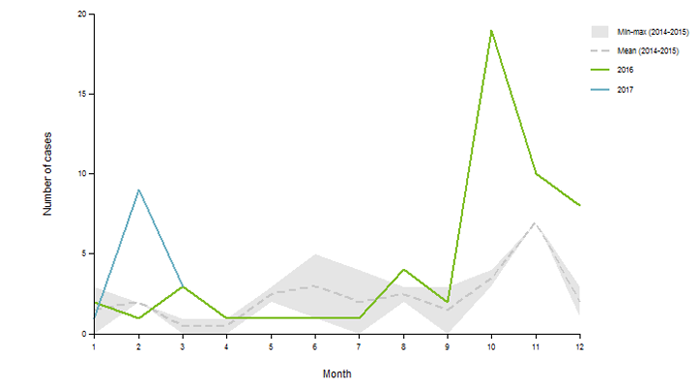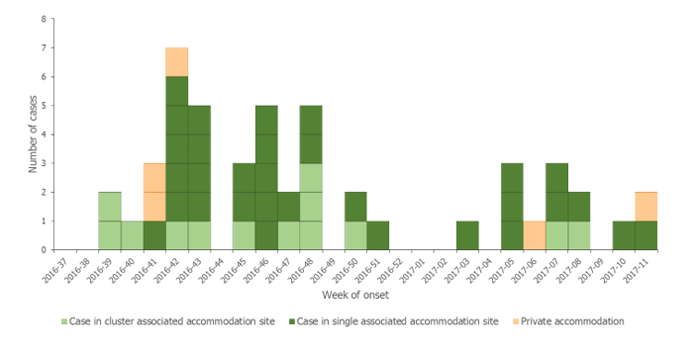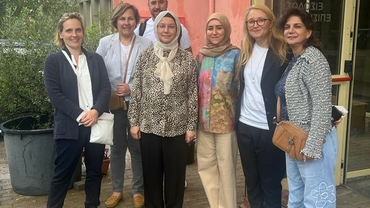Epidemiological update: Legionnaires’ disease cases associated with travel to Dubai, 6 April 2017
The ECDC surveillance scheme (ELDSNet) for travel-associated Legionnaires’ disease (TALD) [1] has observed an increase in the number of cases associated with travel to Dubai, United Arab Emirates (UAE) since the beginning of the last quarter of 2016 compared with the two previous years
Increase in travel-associated Legionnaires’ disease among European travellers returning from Dubai since 1 October 2016.
The ECDC surveillance scheme (ELDSNet) for travel-associated Legionnaires’ disease (TALD) [1] has observed an increase in the number of cases associated with travel to Dubai, United Arab Emirates (UAE) since the beginning of the last quarter of 2016 compared with the two previous years (Figure 1). The doubling of cases observed in October and November 2016 (compared with 2014 and 2015) led to an ECDC rapid risk assessment published on 23 December 2016. As cases continued to be reported in December and January, an ECDC epidemiological update was published on 17 January 2017 and updated on 9 March 2017. This third epidemiological update shows a larger number of cases reported in February 2017 than in the months of February of 2014-2016.
Figure 1. Distribution of TALD cases in connection with travel to Dubai (UAE) by month of onset, EU/EFTA countries, 2014-2017, as of 6 April 2017

As of 6 April 2017, 50 TALD cases with a history of travel to Dubai within 2–10 days prior to illness and with onset since 1 October 2016, have been reported to ECDC by EU Member States and one European Free Trade Association (EFTA) country. Forty-five cases associated with commercial accommodation sites were reported through the ELDSNet TALD surveillance scheme and five cases associated with private accommodation sites in Dubai were reported by the United Kingdom (UK). Cases were reported by the United Kingdom (24 cases), Sweden (6), the Netherlands (5), Denmark (4), France (3), Germany (3), Austria (1), Belgium (1), Hungary (1), Spain (1) and Switzerland (1).
The delay between week of illness onset and week of reporting cases to ELDSNet is around two weeks, ranging from one to six weeks. Therefore, the number of cases reported in the past six weeks is likely to be underestimated.
Figure 2. Distribution of TALD cases with history of stay in Dubai (UAE), by week of onset and accommodation site clustering, weeks 37/2016–11/2017, and as of 6 April 2017 (excluding one case with accommodation site unknown)

Nine of forty-five cases (20%) spent time in another location in UAE or in a country other than their home country during their incubation period. One of the notified cases is reported as a fatal case.
All cases are laboratory confirmed. Thirty-eight were diagnosed with a urinary antigen test (UAT), four with PCR, five with both UAT and PCR, and three by culture, UAT and PCR. Three of the cases had their infection further characterised as Legionella pneumophila serogroup 1, sequence base type 616, and one as Legionella pneumophila serogroup 1, sequence base type 2382. Sequence base type 616 is uncommon in Europe and has been associated with other Legionnaires’ disease cases returning from Dubai in previous years (personal communication, ELDSNet network). While sequence base type 2382 is the first such identification worldwide and appears to be closely-related to type 616. The UAE authorities have informed ECDC that there was no increase observed in statutory notifiable pneumonia cases in Dubai during the period October to December 2016.
Environmental investigations
Public health authorities in the UAE informed ECDC that environmental investigations were undertaken at the notified hotels and Legionella count results within the Dubai municipality showed acceptable levels for water systems (<1000 cfu/litre) [2]. The threshold of acceptability is the same as that indicated in the European technical guidelines by EWGLI [3]. No information from the UAE authorities has been provided to ECDC as to whether other environmental investigations have been carried out in Dubai.
ECDC threat assessment for the EU
The assessment outlined in the rapid risk assessment published on 23 December 2016 has not changed, since cases have continued to be reported with illness onset in recent weeks.
References
- European Centre for Disease Prevention and Control. European Legionnaires’ Disease Surveillance Network (ELDSNet) − Operating procedures. Stockholm: ECDC; 2012.
- Dubai Municipality, Public Health and Safety Department. Dated 06/2010. Guidelines for the control of Legionella in water systems.
- EWGLI technical guidelines for the investigation, control and prevention of travel-associated Legionnaires’ disease. [Accessed 11 January 2017] Available from: http://ecdc.europa.eu/sites/portal/files/media/en/healthtopics/legionnaires_disease/ELDSNet/Documents/EWGLI-Technical-Guidelines.pdf






